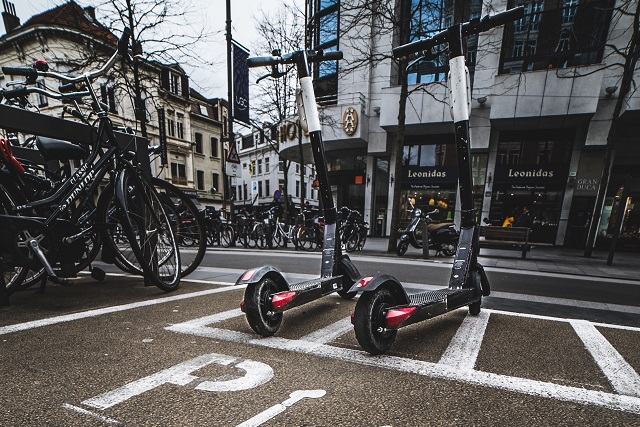
When shopping for a car, you’ll find numerous websites and guides that provide detailed information on their costs and performance, plus ratings and reviews. However, there is much less data about emerging transportation technologies and services that are poised to affect our lives and communities, like e-bikes, ride-hailing, and even futuristic but not far off technologies like pneumatic tube trains, autonomous cars and drones. Information about those technologies is often incomplete, speculative and biased.
These new mobility modes and services, or “new mobilities,” have tantalizing potential. They may allow people to scoot, ride and even fly like never before. However, they can also impose significant costs and risks. We need objective and comprehensive analysis to determine whether they should they be mandated, encouraged, regulated, restricted or forbidden.
A little skepticism is appropriate. Advocates offer images of happy passengers traveling in sleek, fast vehicles, but the reality may be very different. New travel modes and services are often less comfortable and more costly than proponents claim. Ridership, revenues and benefits may be much smaller than optimists predict, and they may make many people worse off overall. For example, autonomous taxi passengers may find garbage and odors left by previous occupants; flying cars can create significant noise, safety and privacy problems; and you may want to shoot down the drones delivering pizza and beer to your neighbor’s late-night party.
This is a timely issue. In the future, households and communities will face countless decisions concerning how to incorporate emerging mobility technologies and services. It is important to make those decisions based on comprehensive analysis. We can’t evaluate each new mobility in the confines of this column, but in a new book, New Mobilities: Smart Planning for Emerging Transportation Technologies, I offer a framework for undertaking a thoughtful analysis.
Who Supplies the Infrastructure? Who Sets the Rules?
Transportation systems are a partnership between users, governments and businesses. Every time someone purchases a car they expect governments to supply roads and businesses to provide parking facilities for their use. We also expect governments to establish traffic rules and liability requirements that protect users and regulations that protect communities from danger and pollution. New mobilities will require similar partnerships.
For example, many of the projected benefits of autonomous vehicles, such as reduced congestion, crash risk and pollution, depend on dedicated lanes that allow platooning – several vehicles driving close together at relatively high speeds. At what point should governments dedicate scarce street and highway lanes to these expensive vehicles? How much should users pay? Who should be liable if a platoon has a multi-vehicle crash?
Consider another issue. If urban road space remains unpriced, as is the norm today, it will often be cheaper for autonomous vehicles to drive in circles, sometimes for hours, rather than pay for parking, although that will increase traffic congestion, crash risks and pollution. How should we regulate or price city streets to prevent these problems?
Similarly, city officials will need to decide whether to build neighborhood terminals for flying cars, whether to allow fast-food drone deliveries, and if so, what rules and taxes should apply.
Recommendations for Better Mobility
With smart planning we can minimize problems and maximize benefits. Here are some questions that communities should ask when evaluating new mobilities:
- Is it affordable? Can disadvantaged groups use it?
- How will it affect non-users, particularly disadvantaged groups?
- What infrastructure will it require and who should pay?
- How will it affect public health and safety? What risks does it impose on others?
- How will it affect community livability, natural environments and resource consumption?
- Will it increase or reduce total vehicle travel? Will it increase or reduce sprawl?
Based on existing literature, when applying these questions to various new mobilities, I found that active modes (walking and bicycling), micro-modes (e-bikes and -scooters), and public transport improvements provide the greatest variety of benefits because they are affordable, healthy and resource efficient.
Vehicle sharing, ride-hailing, MaaS (mobility as a service), and telework are somewhat more costly and resource intensive but still provide numerous benefits, particularly if they help reduce total vehicle traffic and sprawl. As a result, their benefits increase if they are implemented in conjunction with vehicle travel reduction incentives and smart growth policies.
Higher-speed modes, including private electric and autonomous vehicles, tunnel roads, pneumatic tube transport, and aviation innovations provide fewer benefits because they are expensive, resource intensive, and impose significant external costs. This is not to suggest that higher-speed, higher-cost modes should be forbidden. Flying cars, tunnel roads and delivery drones may be appropriate for some trips. However, because of their limited benefits and large external costs, their use should be regulated and priced for efficiency and fairness.
To prepare for the future we must frighten, reassure and plan. We need to scare decision-makers about the potential risks of new mobilities. We also need to reassure them that excellent solutions are available. We must identify the specific policies and programs needed to maximize their benefits and minimize their costs.
New mobility is no panacea. No magical thinking please! Communities must be discerning; we must be willing to say “no,” when necessary, to ensure that emerging transportation technologies and services truly benefit everyone.
Todd Litman is the author of New Mobilities: Smart Planning for Emerging Transportation Technologies and founder and executive director of the Victoria Transport Policy Institute, an independent research organization dedicated to developing innovative solutions to transport problems.








